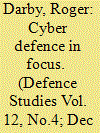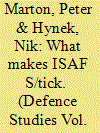|
|
|
Sort Order |
|
|
|
Items / Page
|
|
|
|
|
|
|
| Srl | Item |
| 1 |
ID:
116324


|
|
|
|
|
| Publication |
2012.
|
| Summary/Abstract |
The management of information and knowledge in the defence sector stands at an interesting juncture. Key dilemmas facing the defence sector are on one hand, identifying and effectively using the increasing potential of technical interoperability; on the other hand, the need for new management practices juxtaposed with the escalating global challenge to security to counteract the rise of cyber crime, cyber espionage and in the extreme, cyber warfare. As a consequence, governments are increasingly identifying their digital infrastructure as a strategic national asset that also needs to be better protected. This paper argues that such threats to the defence sector from cyberspace challenge existing paradigms for managing information and knowledge and suggests a more radical approach to gaining knowledge superiority is prescient to remain agile in the fast-moving, technologically advanced defence cyberspace. This paper posits the view that if the defence sector acknowledges information and knowledge as a strategic asset it needs to be more aware of the advantages of knowledge management (KM) and place it at the centre of the strategic management approach. This research also highlights the importance of the production and application of knowledge to manage the developing potential threats to the battle space, the business space and now cyberspace.
|
|
|
|
|
|
|
|
|
|
|
|
|
|
|
|
| 2 |
ID:
116323


|
|
|
|
|
| Publication |
2012.
|
| Summary/Abstract |
This article examines models for the organisation of defence at the highest level and considers their suitability to operate in the contemporary strategic environment. We characterise the contemporary environment and test against this characterisation a 'separated' model for strategic-level defence organisation, which contains distinct political strategic and military strategic structures and functions, and an 'integrated' model in which these structures and functions have been brought together. From this analysis, and by drawing on the experiences of the commercial sector, we conclude that in matching the environment, an integrated model offers considerably more and clearer advantages than a separated one.
|
|
|
|
|
|
|
|
|
|
|
|
|
|
|
|
| 3 |
ID:
116322


|
|
|
|
|
| Publication |
2012.
|
| Summary/Abstract |
This article makes an original contribution to the ongoing debate about British security policy and strategy by investigating for the first time the conceptual 'gap' separating the Ministry of Defence (MoD) and the Foreign and Commonwealth Office (FCO). It argues that there exists a genuine contrast in how the MoD and FCO conceive of the international system itself and Britain's place within it. The article analyses the indigenous worldviews of the departments - the assumptions, thought-processes, and conceptual paradigms employed by the MoD and FCO. Given the current determination to increase 'joined-up' Government, this problem needs to be acknowledged and discussed.
|
|
|
|
|
|
|
|
|
|
|
|
|
|
|
|
| 4 |
ID:
116325


|
|
|
|
|
| Publication |
2012.
|
| Summary/Abstract |
The presented article conceptualises the issue of over- and under-contribution in coalition operations; that of how and why members of complex coalitions may be punching above and below their weight, respectively. The first section presents a parsimonious baseline assumption regarding what variables may fundamentally inform coalition burden-sharing, to subsequently discuss how much each of these are found to play a role in the context of the ISAF (International Security Assistance Force) mission in Afghanistan. The second section elaborates on this by assessing the perception and the interpretation of threats by coalition members countries, related to Afghanistan. The third and fourth sections then proceed to examine and further enrich the existing literature on coalition burden-sharing, and provide further insights regarding the ISAF operation,. Preliminary findings are presented in the fifth section where we offer raw evidence of the relevance of our baseline assumptions. In the sixth section, we present integrated models of the key variables that play a role in shaping coalition contributions, and here two key periods form the focus of this study. On the one hand, we focus on the period of ISAF's cross-country involvement in Afghanistan, following ISAF's expansion of its operations to the south of Afghanistan in mid- 2006, up to mid-2011. Subsequently, we draw conclusions as to how the distribution of countries with different approaches or "commitment postures" may have affected Afghanistan strategy and developments on the ground in the context of the ongoing insurgencies. In the final section, we refine our initial baseline assumptions and the hypothesised country profiles which were based on the latter, with reference to a recently published collection of country case studies by a team of scholars.
|
|
|
|
|
|
|
|
|
|
|
|
|
|
|
|
|
|
|
|
|